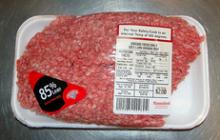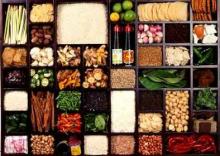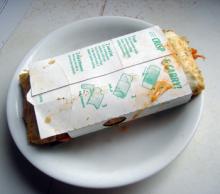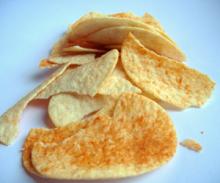In the last few years, I have really gone out of my way to clean up my eating habits. Long gone are the days when I would eat at McDonald's for lunch, and have a bag of gummi bears for dinner. Not to put too fine a point on it, but long gone are the days of Pringles.
I was caught by surprise with a wave of nostalgia when I encountered a Pringles display at the Rite Aid yesterday. Then I realized that Lay's STAX were on sale for only a buck a tube, so I bought those instead. (Nostalgia only goes so far.)
In reviewing these, I have difficulty determining what is bad chip design, what is memories filtered through rose-colored glasses, and what is food that was once familiar but now seems strange. I will say that if you spend a lot of time eating real food - fruit, vegetables, whole grains, meals you cook yourself from single-source ingredients - Lay's STAX seem quite strange. Alien, even.
At first, I couldn't figure out how chips would fit into the strange, barbell-shaped container. And unlike the Pringles cardboard canister (which is recyclable, or at least compostable), the STAX container is 100% plastic. Boo! BOO!
It's hard enough to finagle some chips out of the round Pringles can. It's even more difficult trying to reach into the oval-shaped STAX can. You are basically forced to pour your chips out on a plate (or a napkin, or - as was the case here at my desk - a sheet of printer paper). And the plastic can clearly confers no benefits as far as protecting the chips, because as you can see from the picture above, when I opened the canister I found myself staring at a big pile of shards.
When I do eat potato chips, I stick to Lay's Original. No weird flavors, no bad chemicals - they are chips that even Michael Pollan would approve of. Lay's Original potato chips have only three ingredients: potatoes, salt, and oil. It doesn't get more simple than that. And the chips are just slices of potato, none of this mushed-up nonsense.
To put things into perspective, Lay's STAX are basically the exact opposite of that.
The first ingredient is "potato flakes." The third ingredient is "potato starch." It includes three different artificial colorings, and both sugar AND corn syrup. And about a dozen other ingredients besides.
I bought Mesquite BBQ, because my experience is that BBQ flavor is usually decent, and strong enough to cover up a lot of flaws. Not in this case. The flavoring is sprinkled in paltry distribution atop one side of the chip. It does little to alleviate the impression of eating a slice of contractor grade pressed chipboard molding.
I also found the uncanny identical shapes to be unnerving. Potato chips should not be the exact same size, shape, and thickness, their edges perfectly smooth and regular. It's just not right.
The taste is bland and starchy. It's impossible to guess the original source material. These could just as easily be corn chips, or rice chips.
I remember eating a lot of this kind of chip when I was younger. And now, I literally have no idea why you would eat these, when there are so many better and more delicious options. In a world where you can buy Tim's Chips in any flavor you could desire, it almost seems criminal to buy Lay's STAX.









